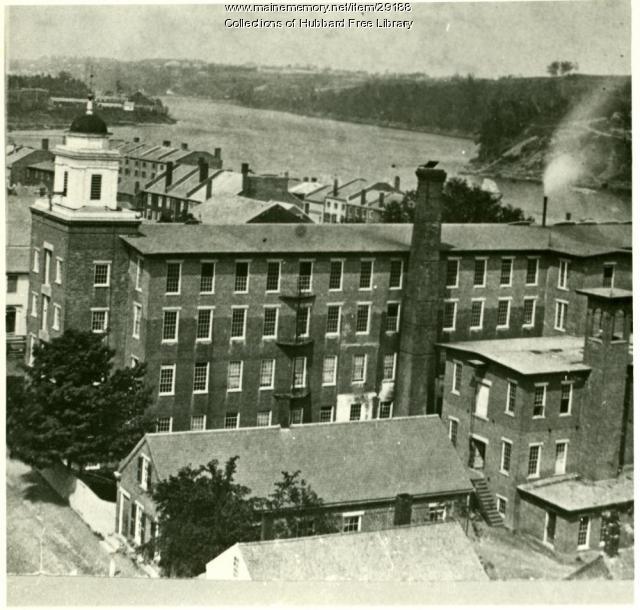Keywords: Aging
Item 52195
Aged Brotherhood rules, Portland, 1876
Contributed by: Maine Historical Society Date: 1876 Location: Portland Media: Ink on paper
Item 52083
Aged Brotherhood payment recommendation, Portland, 1875
Contributed by: Maine Historical Society Date: 1875 Location: Portland Media: Ink on paper
Item 45335
Assessor's Record, 131-133 Danforth Street (rear), Portland, 1924
Owner in 1924: Home for Aged Men Use: Stable
Item 45336
Assessor's Record, 131-133 Danforth Street, Portland, 1924
Owner in 1924: Home for Aged Men Use: Garage
Item 116614
Home for aged women, Portland, 1900-1926
Contributed by: Maine Historical Society Date: 1900–1926 Location: Portland Client: unknown Architect: John Calvin Stevens and John Howard Stevens Architects
Item 116615
Home for Aged Men, Portland, 1915-1924
Contributed by: Maine Historical Society Date: 1915–1924 Location: Portland Client: G. W. Brown Architect: John Calvin Stevens and John Howard Stevens Architects
Exhibit
In Time and Eternity: Shakers in the Industrial Age
"In Time and Eternity: Maine Shakers in the Industrial Age 1872-1918" is a series of images that depict in detail the Shakers in Maine during a little explored time period of expansion and change.
Exhibit
The small town of Andover landed on the international map in 1962 when the Earth Station that had been built there successfully communicated with Telstar, the first telecommunications satellite.
Site Page
View collections, facts, and contact information for this Contributing Partner.
Site Page
Historic Hallowell - Child Labor
"A lot of children worked at the age of seven, they worked in mills or moving heavy loads. The children didn't get time to play or rest; and they…"
Story
Lionel "Toots" Bouthot: A life filled with music
by Biddeford Cultural & Heritage Center
From the age of 5, a lifetime of contributing to the musical fabric of Biddeford.
Story
Growing up DownEast
by Darrin MC Mclellan
Stories of growing up Downeast
Lesson Plan
Grade Level: 3-5, 6-8, 9-12
Content Area: Social Studies, Visual & Performing Arts
"In the four quarters of the globe, who reads an American book?" Englishman Sydney Smith's 1820 sneer irked Americans, especially writers such as Irving, Cooper, Hawthorne, and Maine's John Neal, until Henry Wadsworth Longfellow's resounding popularity successfully rebuffed the question. The Bowdoin educated Portland native became the America's first superstar poet, paradoxically loved especially in Britain, even memorialized at Westminster Abbey. He achieved international celebrity with about forty books or translations to his credit between 1830 and 1884, and, like superstars today, his public craved pictures of him. His publishers consequently commissioned Longfellow's portrait more often than his family, and he sat for dozens of original paintings, drawings, and photos during his lifetime, as well as sculptures. Engravers and lithographers printed replicas of the originals as book frontispiece, as illustrations for magazine or newspaper articles, and as post cards or "cabinet" cards handed out to admirers, often autographed. After the poet's death, illustrators continued commercial production of his image for new editions of his writings and coloring books or games such as "Authors," and sculptors commemorated him with busts in Longfellow Schools or full-length figures in town squares. On the simple basis of quantity, the number of reproductions of the Maine native's image arguably marks him as the country's best-known nineteenth century writer. TEACHERS can use this presentation to discuss these themes in art, history, English, or humanities classes, or to lead into the following LESSON PLANS. The plans aim for any 9-12 high school studio art class, but they can also be used in any humanities course, such as literature or history. They can be adapted readily for grades 3-8 as well by modifying instructional language, evaluation rubrics, and targeted Maine Learning Results and by selecting materials for appropriate age level.
Lesson Plan
Longfellow Studies: "The Jewish Cemetery at Newport"
Grade Level: 6-8, 9-12
Content Area: English Language Arts, Social Studies
Longfellow's poem "The Jewish Cemetery at Newport" opens up the issue of the earliest history of the Jews in America, and the significant roles they played as businessmen and later benefactors to the greater community. The history of the building itself is notable in terms of early American architecture, its having been designed, apparently gratis, by the most noted architect of the day. Furthermore, the poem traces the history of Newport as kind of a microcosm of New England commercial cities before the industrialization boom. For almost any age student the poem could be used to open up interest in local cemeteries, which are almost always a wealth of curiousities and history. Longfellow and his friends enjoyed exploring cemeteries, and today our little local cemeteries can be used to teach little local histories and parts of the big picture as well.
Henry Wadsworth Longfellow visited the Jewish cemetery in Newport, RI on July 9, 1852. His popular poem about the site, published two years later, was certainly a sympathetic portrayal of the place and its people. In addition to Victorian romantic musings about the "Hebrews in their graves," Longfellow includes in this poem references to the historic persecution of the Jews, as well as very specific references to their religious practices.
Since the cemetery and the nearby synagogue were restored and protected with an infusion of funding just a couple years after Longfellow's visit, and later a congregation again assembled, his gloomy predictions about the place proved false (never mind the conclusion of the poem, "And the dead nations never rise again!"). Nevertheless, it is a fascinating poem, and an interesting window into the history of the nation's oldest extant synagogue.





















